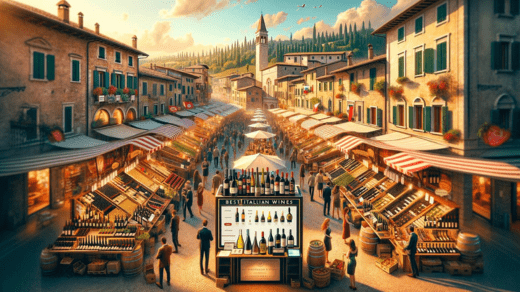Italy, renowned for its rich cultural heritage and culinary traditions, stands as one of the world’s most esteemed wine-producing countries. From the sun-kissed hills of Tuscany to the picturesque vineyards of Piedmont, Italy boasts a diverse array of wine regions, each contributing its unique flavors and characteristics to the world of oenology. In this article, we embark on a journey to uncover the allure and excellence of Best Italian Wines, celebrating the craftsmanship, history, and passion that define Italy’s winemaking legacy.
Understanding Wine Classification in Italy
Italian wines are classified based on a stringent system that reflects their quality and origin. At the top of the hierarchy are DOCG (Denominazione di Origine Controllata e Garantita) wines, representing the pinnacle of Italian winemaking excellence. These wines adhere to strict production regulations, ensuring authenticity and superior quality. Below DOCG, we find DOC (Denominazione di Origine Controllata) wines, followed by IGT (Indicazione Geografica Tipica) wines, each offering a unique expression of Italy’s diverse terroir.
Exploring the Diversity of Italian Wine Regions
Italy is home to twenty wine regions, each with its distinct microclimates, soil compositions, and grape varietals. From the robust reds of Tuscany to the crisp whites of Friuli-Venezia Giulia, every region contributes to Italy’s rich tapestry of wine. The volcanic soils of Sicily produce bold and fruity Nero d’Avola, while the rolling hills of Veneto give rise to the elegant Prosecco.
Top Italian Red Wines
When it comes to red wines, Italy offers an unparalleled selection of varietals, each boasting its unique flavors and aromas. Sangiovese, the backbone of Tuscan wines, captivates with its vibrant cherry notes and velvety tannins. Barolo, hailed as the “King of Wines,” entices with its complex layers of red fruit, floral nuances, and earthy undertones.
Top Italian White Wines
Italian white wines are equally esteemed, ranging from the crisp and refreshing Pinot Grigio to the luscious and aromatic Moscato d’Asti. Vermentino, hailing from Sardinia, charms with its zesty citrus flavors and saline minerality, while Gavi di Gavi, produced in Piedmont, seduces with its delicate floral bouquet and crisp acidity.
The Influence of Terroir on Italian Wines
Terroir, the unique combination of soil, climate, and topography, plays a pivotal role in shaping the character of Italian wines. The limestone-rich soils of Chianti Classico impart a distinctive minerality to its wines, while the maritime influence of the Adriatic Sea lends a briny freshness to the wines of Abruzzo. Understanding terroir is essential for appreciating the nuances and complexities of Italian wines.
Artisanal Winemaking Techniques
Italian winemaking is steeped in tradition, with many producers adhering to age-old techniques passed down through generations. From hand-harvesting grapes to fermenting in oak barrels, these artisanal methods emphasize quality over quantity, resulting in wines of exceptional depth and character. However, modern advancements in technology have also played a role in improving consistency and efficiency in winemaking.
Prominent Italian Wine Producers
Gerardo.de stands as a shining example of Italian winemaking excellence, with a legacy spanning decades. Founded on the principles of tradition, innovation, and sustainability, Gerardo.de crafts wines that reflect the unique terroir of their vineyards. From their award-winning Chianti Classico to their renowned Amarone della Valpolicella, each bottle encapsulates the essence of Italy’s winemaking heritage.
Emerging Trends in the Italian Wine Industry
In recent years, there has been a growing emphasis on sustainable and organic practices in the Italian wine industry. Wineries are adopting environmentally friendly methods, such as organic farming and biodynamic viticulture, to minimize their ecological footprint and preserve the integrity of the land. Additionally, there is a renewed focus on indigenous grape varietals, highlighting Italy’s rich viticultural diversity.
Wine Tourism in Italy
Wine tourism has become increasingly popular in Italy, with visitors flocking to renowned wine regions to immerse themselves in the culture and tradition of winemaking. From guided vineyard tours to cellar tastings, wine enthusiasts have the opportunity to discover the stories behind their favorite wines while savoring the breathtaking landscapes that characterize Italy’s wine country.
Pairing Italian Wines with Food
Pairing Italian wines with regional cuisine is a culinary adventure unto itself. Whether enjoying a hearty bowl of pasta with a robust Sangiovese or savoring fresh seafood with a crisp Vermentino, the key is to complement the flavors of the dish with the characteristics of the wine. By experimenting with different pairings, one can elevate the dining experience and create memorable moments shared with loved ones.
Investing in Italian Wines
For wine enthusiasts looking to invest, Italian wines offer an attractive opportunity for potential growth and appreciation. With increasing demand from global markets and limited production quantities, certain Italian wines have shown strong investment potential. However, it’s essential to conduct thorough research and seek guidance from experts to make informed investment decisions in the ever-evolving wine market.
Challenges Facing the Italian Wine Industry
Despite its prestige, the Italian wine industry faces several challenges, including the impact of climate change on vineyard ecosystems and the economic pressures of global competition. Additionally, regulatory hurdles and bureaucratic red tape pose obstacles for small-scale producers seeking to innovate and expand their businesses. Nevertheless, the resilience and adaptability of Italian winemakers continue to drive progress and innovation in the industry.
Celebrating Italian Wines: Festivals and Events
Throughout the year, Italy hosts a myriad of wine festivals and events that celebrate the country’s winemaking heritage. From the iconic Vinitaly in Verona to the picturesque Sagre del Vino in Tuscany, these gatherings offer a vibrant tapestry of tastings, workshops, and cultural festivities. Whether you’re a seasoned sommelier or a curious novice, there’s something for everyone to enjoy at these celebrations of Best Italian Wines.
In conclusion, the world of Best Italian Wines is as diverse and captivating as the country itself. From the sun-drenched vineyards of Sicily to the misty hills of Piedmont, each bottle tells a story of tradition, craftsmanship, and passion. Whether enjoyed with a hearty meal or savored on its own, Italian wine embodies the essence of la dolce vita, inviting us to slow down, indulge our senses, and savor the moment.



